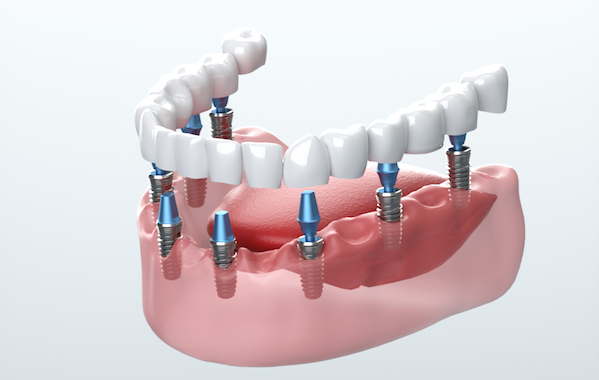Getting The Dental Implants To Work
Rumored Buzz on Dental Implants
Table of ContentsAll about Dental ImplantsA Biased View of Dental ImplantsThe Ultimate Guide To Dental ImplantsUnknown Facts About Dental Implants
are medical devices surgically implanted into the jaw to bring back an individual's capability to eat or their look. They offer support for artificial (phony) teeth, such as crowns, bridges, or dentures. When a tooth is shed as a result of injury or illness, a person can experience difficulties such as quick bone loss, defective speech, or adjustments to chewing patterns that lead to pain.
Structure of The Oral Implant System choosing dental implants, talk to your oral supplier about the potential advantages and threats, and whether you are a candidate for the treatment. Things to consider: Your overall health and wellness is an important factor in determining whether you are an excellent candidate for dental implants, how much time it will take to heal, and the length of time the implant may remain in location.
Smoking cigarettes may affect the healing procedure and lower the long-lasting success of the dental implant. The recovery procedure for the dental implant body may take several months or longer, during which time you usually have a momentary joint in place of the tooth. the oral implant treatment: Very carefully follow the oral health instructions provided to you by your dental provider.
Dental Implants Things To Know Before You Get This
Implant failing can cause the requirement for one more surgery to fix or change the implant system. Restores the capability to eat Brings back aesthetic look Helps keep the jawbone from shrinking because of bone loss Protects the health of the bordering bone and periodontals Helps keep nearby (nearby) teeth secure Improves high quality of life Damage to surrounding all-natural teeth during dental implant placement Injury to the surrounding tissues during surgical procedure, such as sinus opening Injury during surgical treatment (as an example, crack of surrounding jawbone) Insufficient feature, such as seeming like the teeth do not bite with each other usually A feeling that the tooth is loosened or turning in position arising from an abutment screw loosening up Implant body failure (looseness of the implant body) as a result of systemic infection, which may be more probable in individuals with uncontrolled diabetes as a result of regional infection in bone and gums sustaining the implant body as a result of delayed recovery, which may be most likely in clients who smoke Trouble cleaning the periodontals around the dental implant, resulting read review in poor dental hygiene Untreated periodontal disease Post-surgical pins and needles because of nerve impingement or damage Constantly notify health and wellness treatment service providers and imaging professionals that you have oral implants before any magnetic vibration imaging (MRI) or x-ray procedures.
FDA is not aware of any type of damaging events reported for MRI or x-ray procedures with oral implants. Oral implants systems are generally made of materials that adhere to global consensus requirements of the International Organization for Standardization (ISO) or ASTM International. These criteria have details of what makes a risk-free material.
Dental implant systems are assessed according to international agreement requirements. Biocompatibility screening, to reveal that bodily contact with the tool does not cause problems like irritation or allergic reaction, is part of the examination that assists make sure the products in the oral implant system are secure and do not cause damaging impacts when dental implanted in people.

The 4-Minute Rule for Dental Implants
Some people are not eligible for oral implant surgery. It is for dental surgeons to operate individuals with: intense illnessuncontrollable metabolic diseasebone or soft cells illness or infectionIf these concerns are fixed, a person our website can have the surgical treatment. Dental Implants. In, dental specialists avoid operating individuals with: If people with any of the above undergo oral implant surgical procedure, there is a greater danger of the implant falling short
Some individuals have a jawbone abnormality that avoids sufficient bone for an implant from developing. The doctor will certainly after that utilize a bone or bone substitute to repair and build up the location.
Oral implant surgery is a tailored process. It's not the very same for everyone. The following offers a basic review of what you can expect your dental professional, dental specialist, periodontist or prosthodontist to do: Place the dental implant operatively. Provide you time to recover. pop over to this site Connect the article and last crown, bridge or denture.
Next off, your cosmetic surgeon will meticulously put the dental implant right into your jaw. If your implant is near the front of your mouth, your dental expert will certainly make a short-lived tooth for you to put on up until you heal.
9 Easy Facts About Dental Implants Explained
Your provider can tell you what to expect in your situation. Throughout the recovery phase, your jawbone needs to fuse to the oral implant. This procedure, called osseointegration, is crucial for stability and lasting success. This process can take anywhere from three to 9 months. Sometimes, it may take longer.
As soon as your implant heals, your dental professional can affix the joint (little connector message) and your final reconstruction (crown, bridge or denture). This generally takes about one hour to complete and might require a 2nd minor surgical treatment. You should not feel any kind of discomfort throughout your dental implant treatment since your provider will certainly utilize medicine to numb your periodontals.